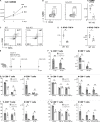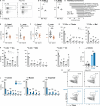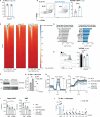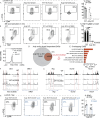ACLY and ACSS2 link nutrient-dependent chromatin accessibility to CD8 T cell effector responses
- PMID: 39150482
- PMCID: PMC11329787
- DOI: 10.1084/jem.20231820
ACLY and ACSS2 link nutrient-dependent chromatin accessibility to CD8 T cell effector responses
Abstract
Coordination of cellular metabolism is essential for optimal T cell responses. Here, we identify cytosolic acetyl-CoA production as an essential metabolic node for CD8 T cell function in vivo. We show that CD8 T cell responses to infection depend on acetyl-CoA derived from citrate via the enzyme ATP citrate lyase (ACLY). However, ablation of ACLY triggers an alternative, acetate-dependent pathway for acetyl-CoA production mediated by acyl-CoA synthetase short-chain family member 2 (ACSS2). Mechanistically, acetate fuels both the TCA cycle and cytosolic acetyl-CoA production, impacting T cell effector responses, acetate-dependent histone acetylation, and chromatin accessibility at effector gene loci. When ACLY is functional, ACSS2 is not required, suggesting acetate is not an obligate metabolic substrate for CD8 T cell function. However, loss of ACLY renders CD8 T cells dependent on acetate (via ACSS2) to maintain acetyl-CoA production and effector function. Together, ACLY and ACSS2 coordinate cytosolic acetyl-CoA production in CD8 T cells to maintain chromatin accessibility and T cell effector function.
© 2024 Kaymak et al.
Conflict of interest statement
Disclosures: Z.P. Fan reported grants from Agios Pharmaceuticals during the conduct of the study. At the time that this research was conducted, T.P. Roddy was employed by Agios Pharmaceuticals. S.M. Kaech reported personal fees from Evolveimmune Therapeutics, Arvinas, Simcha Therapeutics, Afffini-T Therapeutics, and Siren Biotechnology outside the submitted work. R.G. Jones reported grants from Agios Pharmaceuticals and Van Andel Institute during the conduct of the study; “other” from Wisent Biosciences and Immunomet Therapeutics; non-financial support from Servier Pharmaceuticals; and personal fees from Agios Pharmaceuticals outside the submitted work. No other disclosures were reported.
Figures












References
MeSH terms
Substances
Grants and funding
- R21AI153997/National Institute of Allergy and Infectious Diseases
- Fonds de Recherche du Québec-Santé
- R01 AI066232/NH/NIH HHS/United States
- Salk Pioneer Fund
- R21 AI151986/AI/NIAID NIH HHS/United States
- T32CA251066-01A1/CA/NCI NIH HHS/United States
- T32 CA251066/CA/NCI NIH HHS/United States
- Chan Zuckerberg Initiative
- R01 AI066232/AI/NIAID NIH HHS/United States
- PJT 192049/Cancer Research Society
- Paul G. Allen Frontiers Group
- R01 AI165722/AI/NIAID NIH HHS/United States
- 2495-23/Daymon Runyon Foundation
- CRI/Cancer Research Institute/United States
- R21 AI153997/AI/NIAID NIH HHS/United States
LinkOut - more resources
Full Text Sources
Molecular Biology Databases
Research Materials

